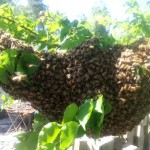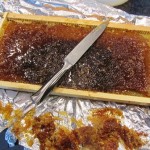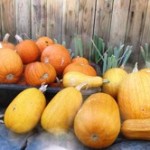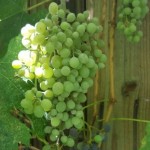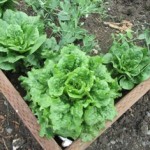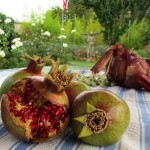Keeping Bees Feeds the Family
The sight of bees collecting pollen makes me happy. Always has. Honeybees are vital to the production of the foods we love such as almonds, apples, citrus, melons, and a large variety of vegetables. My vegetable garden and fruit trees are incredibly productive because of my backyard bees. I guess you could say they feed my family through pollination.
Bees are pollinators. Without them there’s a good chance we’d suffer food scarcity on our planet. Three out of four crops around the globe that are foods that we humans eat are dependent in large part on pollinators. Honeybees also produce honey, nature’s most delicious sweetener, in my opinion.
I keep hives of honeybees on my farmette. It’s not a commercial operation but a backyard hobby that supplies honey for my family and friends as well as pollinating a huge variety of vegetables, fruits, and berries that I grow. Caring for the bees is relatively easy. Harvesting honey, on the other hand, is a bit of work but work I am happy to do.
The first step in harvesting honey is to open the hives. The use of a smoker helps calm the bees. Working quickly is a good idea. We never remove all frames of honey from the hive, but rather leave frames with baby bees and some frames with honey so the bees have food, too.
New frames (some are previously used frames that have the wax structure intact) are inserted to replace the removed frames of honey. A super with 10 frames of honey is carried into my kitchen. Inevitably, I have to capture and release a half dozen live bees that ride in on the frames.
Each frame then gets a hot knife slipped just under the layer of wax. With the wax removed from both sides of the frame, only honey is left. This must be spun out or drained off.
I put four frames of honey at a time into the spinning machine in my kitchen. Beneath the machine’s spigot is freshly washed honey bucket, draped with a new cloth strainer that I’ve taped in place over the top of the bucket. It will catch any pieces of wax or other debris.
When the bucket is full, the strained honey is poured into jars to use, store, or give away as gifts. I put a tight-fitting lid on the bucket and keep the bucket within easy reach on the kitchen countertop.
We eat honey year round. I especially love it in the winter because it reminds me of the honey-flow in spring when the farmette smells like honey and my kitchen is saturated with the scent after pulling some frames from the hive.
Also, the vegetables and fruits that I harvest throughout the growing season are either immediately consumed or preserved through hot-water canning, dehydration, flash freezing. I thank Mother Nature for the blessing of bees that pollinate our foods and give us delicious honey from their hive–up to six gallons for ten frames from a full-depth box!
*NOTE: Learn more about honey bees at: https://www.nationalgeographic.com/animals/invertebrates/h/honeybee/
Also, check out: https://honeybeenet.gsfc.nasa.gov/Honeybees.htm
___________________________________________________________
Enjoy reading about country living? Check out my Henny Penny Farmette series of cozy mysteries that also include lists of farm chores, delicious recipes, farm sayings, and tips for healthy living. Or, take a look at my health, wellness, and spirituality books. All are available online and everywhere books are sold.

More than 150 rituals for sound mind, strong body, and meaningful connections to the people around you
The Summer Garden Is Done, What’s Next?
My summer garden is wild and chaotic and bountiful at the beginning of the season. You’ll find fruit trees, vegetables, vines of melons, corn, and perennial lavender and other showy herbs and flowers. Like a grand dame of faded elegance, the garden has matured and looks a bit weary and spent now that Labor Day approaches.
Just because the peak growing season is coming to an end, it’s not the end of garden chores. The following tasks can be started now.
HARVEST AND STORE
For some crops, the harvesting goes on. Examples include tomatoes, potatoes, melons, and winter squashes like Butternut that store well. If you haven’t already harvested the garlic, it’s a good time to do that.
Cut sunflower seed heads and place them in a warm area to dry. Collect seeds from cosmos, nasturtiums, and other flowers to preserve for next year’s garden. Work out storage options, especially for food items to be harvested.
Snip summer table grapes and other varieties if they are ripe . . . or let them hang a while longer for extra sweetness.
CLEAR BEDS
Depleted, dying, or dried annuals can be dug, pulled, and composted now. If you plan to let the garden rest, plant a cover crop so the ground doesn’t become hard scrabble. The cover crop will feed the soil.
DO FALL PLANTING
If you intend to do a fall planting, take time now to enrich the earth with amendments. Turn and rake the garden soil. Put plants directly into the prepared earth and water well to get them off to a good start.
For quick second crop before the weather turns cold, plant greens such as spinach, kale, and arugula. Cool season crops like beets, broccoli, and cabbage can go directly into the ground now, too.
CUT FLOWER AND SEED HEADS
Cut flower heads of hydrangeas for drying. Insert plant markers near peonies and other perennials that will die completely back during winter. Gather bunches of mint and other herbs, tie with string, an hang in a cool, dark place to dry.
CREATE MULCH
Designate an area to create a new compost pile. Use garden detritus and fall leaves as the trees begin to drop their canopies to enter winter dormancy. The resulting mulch will enrich the soil for next year’s garden.
CHECK ON FALL PRODUCE
Pomegranates, persimmons, and pumpkins will soon be ripening. Ensure that these plants continue to get water. Check for pests and any signs that might indicate nutrient deficiencies that could show up in the leaves. Figure out your options for storing or gifting excess fruits and veggies. For example, pomegranates keep well in the fridge or remove the seeds and put into bags for freezing. Save and dry rinds for potpourri.
TURN THE SOIL IN GROW BOXES
Aerate and amend soil in grow boxes and raised beds for cool season crops. Do these chores before the rainy season and cool weather arrives. Your garden, like a young maiden who flourishes from attention, will produce bountiful vegetables, fruits, berries, and flowers during its next growing season.
_______________________________________________________________
If you enjoy reading about farmette topics, gardening, and keeping chickens and honeybees, check out my series of cozy mysteries from Kensington Publishing in New York.
Click on this link: http://tinyurl.com/ya5vhhpm
My newest nonfiction book is published by Adams Media/Simon & Schuster: http://tinyurl.com/y9vfw2t9
- Anyone can find peace, clarity, and focus…all it takes is a moment
 Facebook
Facebook Goodreads
Goodreads LinkedIn
LinkedIn Meera Lester
Meera Lester Twitter
Twitter





